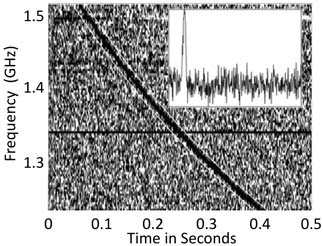|
A
great many papers have recently appeared describing what is known, and
mostly what isn’t known, about FRBs (Fast Radio Bursts).
FRBs
are very brief, very energetic, high frequency radio impulses of
unknown cosmic origin. FRBs are a relatively recent discovery, and our
understanding of them is rapidly changing.
In the last 17 years, astronomers have cataloged over 100 FRBs. The longest lasted 26 milliseconds (0.026 sec), while the shortest lasted less than 0.05 milliseconds. Their peak energy can exceed the normal emission of an entire galaxy.
Scientists
suspect FRBs originate in galaxies, since almost all other high-energy
events are produced in galaxies. But, they also believe the FRBs we do
see must occur in the outskirts of those galaxies, otherwise they would
be absorbed by gas and dust in their own galaxy and never reach ours.
Astronomers can estimate the distance to the source of a FRB, because radio waves are dispersed as they traverse ionized gas [see footnote for more details]. The estimated distances of FRBs range from 0.5 to 8 billion light-years — all well beyond the confines of our Milk Way galaxy.
Although
we know the direction from which each FRB arrives, and we know how far
away its source is, astronomers have only been able to match 5 FRB
sources with known galaxies. The rest may well come from yet
undiscovered galaxies — the observable universe contains 100 billion
galaxies, and we have cataloged just a few million so far.
 In
this chart of a FRB from Swinburne University of Australia, the black
stripe shows the rapidly decreasing frequency (vertical axis) versus
time (horizontal axis) that is typical of FRBs. We believe FRB sources
emit all frequencies simultaneously — dispersion preferentially delays
lower frequencies. In
this chart of a FRB from Swinburne University of Australia, the black
stripe shows the rapidly decreasing frequency (vertical axis) versus
time (horizontal axis) that is typical of FRBs. We believe FRB sources
emit all frequencies simultaneously — dispersion preferentially delays
lower frequencies.
Some FRB sources are repeaters;
they produce FRBs at irregular intervals. But most FRB sources seem to
be non-repeaters; we have only detected 1 FRB from each of them so far.
Within a 6-year span, one oddly shaped dwarf galaxy 2.5
billion light-years away produced 34 FRBs. A second source produced 10,
and a third produced 6, but these sources have not been matched to any
known galaxies. A fourth source, 0.5 billion light years away, produced 4
FRBs, and was found to be a massive spiral galaxy.
It’s
remarkable that the FRBs from the massive spiral galaxy have about ten
times less energy than the FRBs from the dwarf galaxy, and as much as a
million times less energy than FRBs from some non-repeaters. Perhaps,
FRBs are produced quite differently in different environments.
There
is also significant uncertainty about the rate of FRBs reaching Earth
from all sources. The Canadian group CHIME estimates 300 FRBs per day,
while the Australian group ASKAP estimates less than 30 per day.
Vikram Ravi of Caltech estimates 700 FRBs are produced each day in each cubic giga-parsec.
Translating that into something closer to English, that’s about 2
million FRBs per day in our entire observable universe, or if you
prefer, about 1 FRB per galaxy per century. Again, this is the rate for
FRBs that escape their own galaxies.
So, what produces these very energetic, very brief radio pluses?
Astrophysicists have many ideas — at least 48 different theories — but none is fully satisfying.
High-energy
cosmic phenomena are generally associated with black holes or compact
stars (white dwarfs or neutron stars). Radio frequency emissions are
generally associated with electrons spiraling in magnetic fields. The
typical frequency of FRB waves, 1 GHz, suggests extremely strong
magnetic fields, and extremely compact sources (200 miles across or
less).
Ravi says FRBs might be produced by collapsing stars or mergers of highly magnetized compact stars.
Metzger, Margalit, and Sironi think FRBs come from newly formed magnetars,
neutrons stars with immense magnetic fields. Magnetars form in the
aftermath of supernovae. After one forms, its surface may churn
violently and occasionally launch flares of extremely high-energy
particles. These flares plowing into supernova debris might produce
shock fronts that intensify magnetic fields. Electrons spiraling in
these fields could produce radio bursts.
Siraj
and Loeb say FRBs are produced by asteroids colliding with neutron
stars, which they estimate happens 10 times a day in a galaxy like ours.
A
key problem with all these suggested sources is that such events
preferentially occur in galaxy centers, where the density of compact
stars is much higher than in the outskirts, where the FRBs we see must
originate.
Ravi
thinks FRB producers may be quite rare, but that all of them burst
repeatedly. We have only seen 11 repeaters, but we have only been
looking for a few years. Perhaps, over centuries, each rare source might
burst 100 times or more, making the number of FRBs much greater than
the number of their sources.
Or FRB sources could be something else entirely.
Could FRBs come from LGM (little green men)?
Sometimes less is more — the less we know about an enigma, the more wild explanations we can imagine.
Science would be a lot less fun if we already understood everything. Fortunately, there’s no danger of that.
Footnote: A wave of a single frequency (in music, a pure tone)
has the same amplitude everywhere. A short-duration wave, such as a
FRB, is comprised of many different frequencies — the shorter the
duration, the broader the frequency spectrum. When traversing plasma
(free electrons and ionized gas), wave components of different
frequencies are dispersed, delayed by different amounts,
according to the plasma’s index of refraction. From the amount of
dispersion, and estimates of intergalactic plasma density, astronomers
can estimate how far an FRB has traveled to reach us.

Best Regards,
Robert
February 2020
Note: Previous newsletters can be found on my website.
|